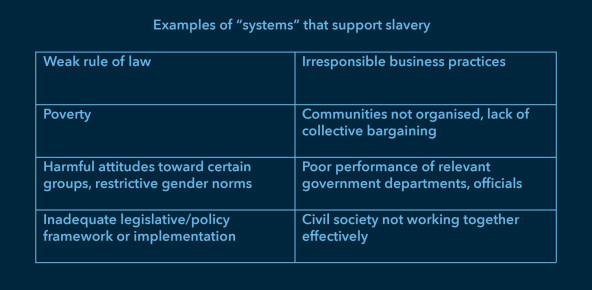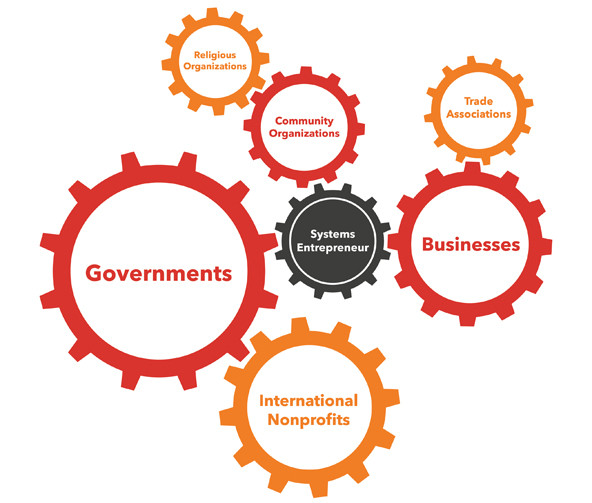Everyone is talking about systems. Or at least, that's how it seems in my wonkish corner of the philanthropic world. You can't attend a conference or even have a meeting without hearing about systems, whether it's people trying to disrupt them, map them, learn from them, or catalyze them.
We're not above it at the Freedom Fund, a global philanthropic initiative to end modern slavery. Far from it. We talk every day about trying to "dismantle" the systems that allow slavery to persist. We've made evidence of systems change one of our organizational key performance indicators. And indeed, we are often cited as a rare example of systems change in action, in that three of the world’s leading funders of anti-slavery work came together in 2013 to create the Freedom Fund as a way of coordinating their efforts and driving change at scale.
But what exactly are these systems we’re all talking about? And do we risk talking past each other if we’re using different definitions?
I see three fairly distinct ways the term is being used, not just in the anti-slavery sector, but across the social change space.
Are you enjoying this article? Read more like this, plus SSIR's full archive of content, when you subscribe.
1. Systems change = addressing root causes
Many people use systems as a synonym for "root causes." Most of us want to move beyond Band-Aid solutions and tackle the underlying causes of social problems. For example, those working in international development often see poverty as a symptom of a deeper problem—such as government corruption or the denial of basic rights to certain groups. NGOs working to help empower communities to claim their rights will say they are working to address the systems that keep poverty entrenched—as opposed to simply providing handouts.
Similarly, in the fight against slavery, a systems change approach might address weak rule of law, harmful attitudes toward women or certain ethnic groups, or irresponsible business practices—in contrast to a narrower approach that focuses on, say, rescuing victims. This is how we tend to use the term at the Freedom Fund, and it underlines the importance we place on preventing people from falling into situations of slavery in the first place.
 Examples of “systems” that support slavery. (Image by the Freedom Fund)
Examples of “systems” that support slavery. (Image by the Freedom Fund)
2. Systems thinking = adapting to complexity
“Systems thinking” is a school of thought that burst onto the international development scene a few years ago but has roots stretching back decades. In the early 2010s, development luminaries such as Owen Barder of the Center for Global Development and Duncan Green at Oxfam Great Britain started arguing that social change is so complex it requires a completely new set of conceptual tools. As Green put it in a 2016 article: “A defining property of human systems is complexity: because of the sheer number of relationships and feedback loops among their many elements, they cannot be reduced to simple chains of cause and effect. Think of a crowd on a city street, or a flock of starlings wheeling in the sky at dusk.”
Green argued that working in complex societies requires the same kind of “iterative, collaborative, and flexible approach.” Instead of making a rigid plan at the beginning of a project based on “best practice” and then commissioning an evaluation at the end to see what worked, development should be more like parenting: Ultimately, it’s about trial and error, an “endless testing of assumptions about right and wrong, a constant adaptation to the evolving nature of the child.”
Systems thinking emphasizes the importance of understanding how the different parts of a system interact, rather than focusing on the parts themselves. Progressive foundations such as Humanity United have led the way in analyzing and identifying ways to influence complex systems, such as those contributing to human trafficking, mass atrocities, and violent conflict.
There’s no doubt that systems thinking has made an important contribution to philanthropy, not least because it has helped manage everyone’s expectations about how much we should reasonably know in advance about the likely outcome of a project. In addition, it has opened up space for project managers to innovate as they go and given donors cover to allow this without seeming irresponsible.
That said, while willingness to adapt to a system mid-stream is all well and good, if you can’t get reliable evidence about what is happening mid-stream and why—which is often the case for a typical three-year project—then “adapting to the system” is hard to do. It is more likely an effective strategy for longer-term projects. Organizations also need to have a good feeling for when efforts to extensively map a given system start to bring diminishing returns.
3. Systems entrepreneurship = catalyzing large-scale change
The systems-related term that seems most on the upswing at the moment is “systems entrepreneur”—usually an organization that can herd many different types of groups around a common, ambitious cause. At the 2017 Skoll World Forum, a panel on systems entrepreneurship described the topic as follows: “The problems we seek to solve—from failed school systems to infectious disease—are too big and tangled for any single organization to address, no matter how innovative or well-funded. We need ‘systems entrepreneurs’ who see large-scale problems require close collaborations across sectors—including governments, nonprofits, and businesses.” One of the panelists was Jeff Walker, a leading thinker on systems entrepreneurship, who has argued that it is time to focus “more on solving problems through creative collaboration, and less on [creating] new institutions.”
But what exactly is a systems entrepreneur? According to Doug Balfour, CEO of the philanthropy advisory firm Geneva Global, the systems entrepreneur is “a central gear … the catalytic force that creates momentum among all the other actors” working on a particular social issue.
This is similar to the “backbone organization” of a collective impact initiative, in which organizations across sectors make a commitment to solving a specific social problem.
Systems entrepreneurship—the notion that there is a particular set of skills and attributes that an organization can develop and perfect to turn the wheels of change—is a powerful idea. Balfour describes a systems entrepreneur as a neutral facilitator, a diplomat, and an honest broker who creates a “climate of shared understanding and results”.
 The systems entrepreneur as a central gear. (Image by Doug Balfour)
The systems entrepreneur as a central gear. (Image by Doug Balfour)
This is a role the Freedom Fund aims to play in our hotspot projects. We bring together 10 to 20 frontline civil society organizations in countries with high levels of slavery, provide them with funding and training, and help them to connect with government and business to drive through reforms—whether to end forced labor in the Thai seafood industry or to improve conditions for adolescent girls working in India’s garment factories.
But it is not always that easy. The big challenge in settings where well-intentioned organizations are trying to create change is that many actors are involved, and many do not wish someone else to coordinate their work. Even when there is a will, competing priorities, timelines, funding sources—sometimes even terminologies—can prevent effective cooperation from happening.
More in common?
Each of these three perspectives on systems contributes important ideas, but clearly they are not the same. And while the field should not necessarily try to harmonize how it uses the term, it’s important that we understand what we mean when we use it in our discussions, and how these perspectives on systems differ and overlap.
In fact, the variations have a lot in common. All are about targeting our efforts at what matters most, rather than the symptoms or individual parts of a problem. All acknowledge the complexity of social change and the interaction of many factors. And all three are ambitious; they seek fundamental, lasting change. That systems seems to be on everyone’s lips is a sign that the philanthropic world is aiming higher, and that can only be a good thing.
Support SSIR’s coverage of cross-sector solutions to global challenges.
Help us further the reach of innovative ideas. Donate today.
Read more stories by Dan Vexler.

